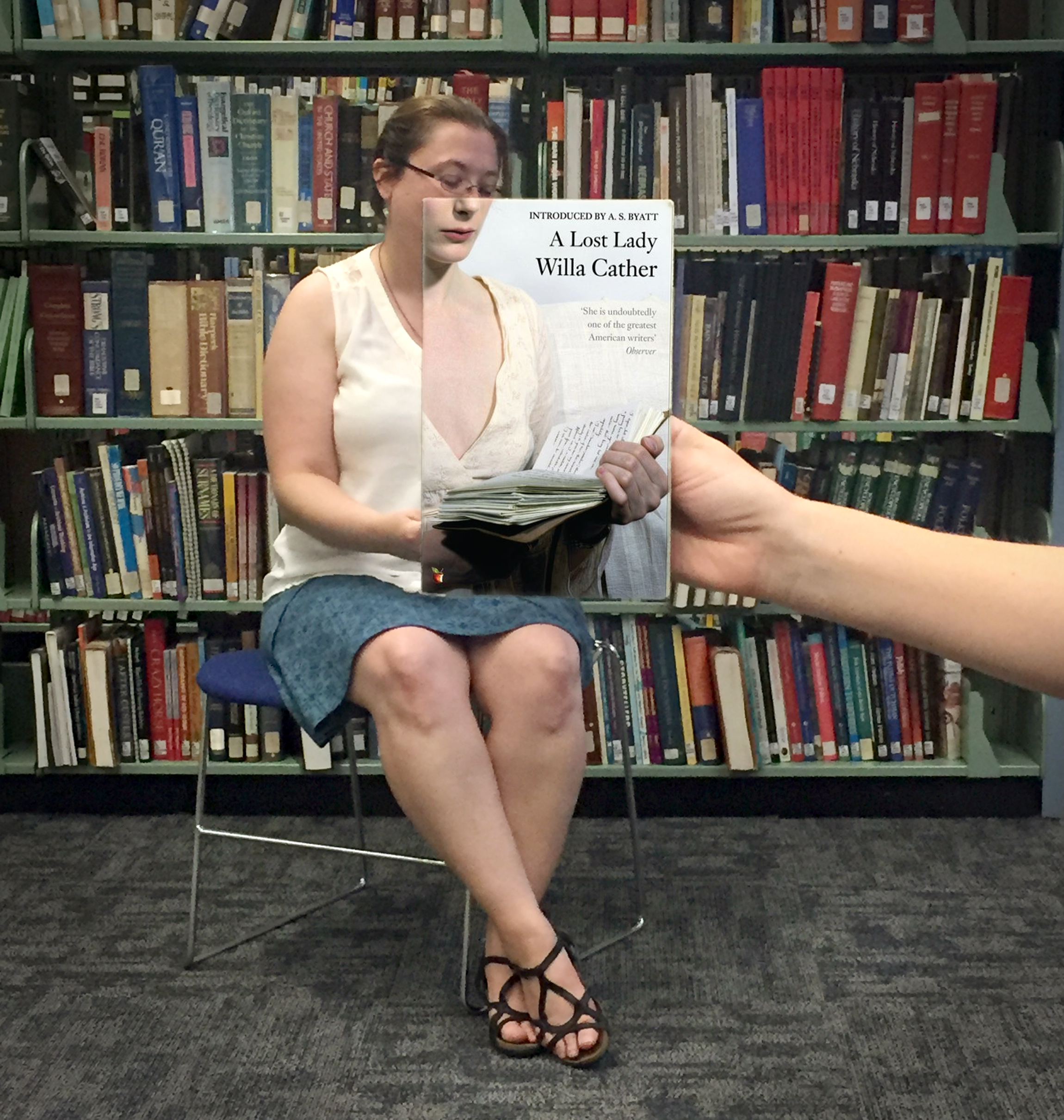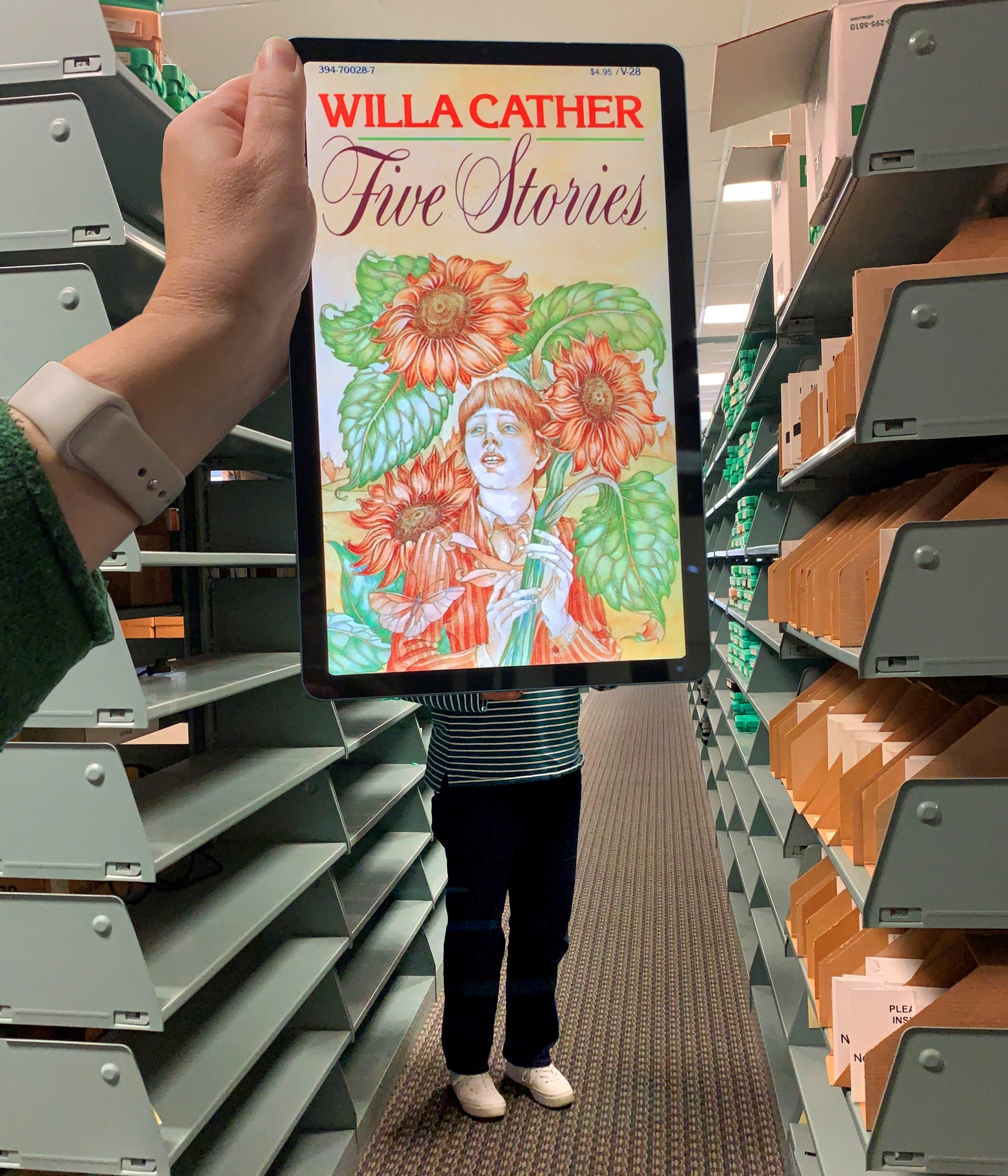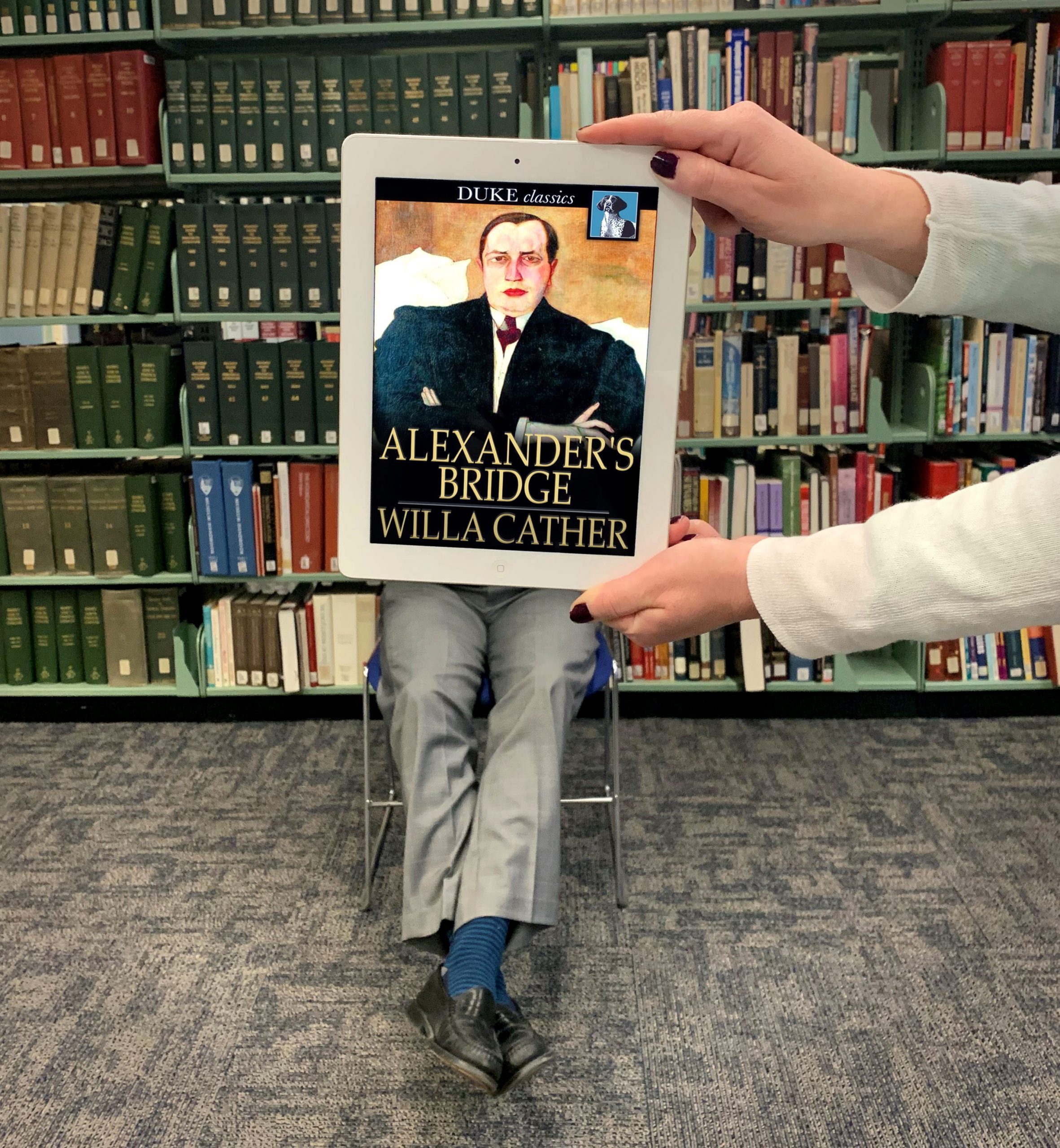Search the Blog
Categories
- Books & Reading
- Broadband Buzz
- Census
- Education & Training
- Friday Reads
- General
- Grants
- Information Resources
- Library Management
- Nebraska Center for the Book
- Nebraska Libraries on the Web
- Nebraska Memories
- Now hiring @ your library
- Preservation
- Pretty Sweet Tech
- Programming
- Public Library Boards of Trustees
- Public Relations
- Talking Book & Braille Service (TBBS)
- Technology
- Uncategorized
- What's Up Doc / Govdocs
- Youth Services
Archives
Subscribe
Tag Archives: Willa Cather
Friday Reads: A Lost Lady, by Willa Cather
While I was enjoying some Barbara Stanwyck films on Turner Classic Movies (star of the month for March 2025), I saw something that surprised me—a mention of Willa Cather in the opening credits for A Lost Lady (Warner Bros., 1934). I’d heard of the 1923 book that Willa Cather wrote with that title, but I’d assumed this was a coincidence. I don’t know as much about Willa Cather as many other Nebraskans might (who might also be reading this right now—hello everyone, in the state and elsewhere, who has a Google alert for Willa Cather! You are a devoted bunch!), but I didn’t remember seeing Cather’s name associated with a relatively contemporaneous movie before.
(This 1934 movie was the second attempt to bring the hit novel to the screen. The first try was in 1924, directed by Harry Beaumont and starring Irene Rich—but don’t go looking for that version, because according to IMDb and others, there are no existing prints of that 1924 movie—it’s considered as “lost” as its title character.)
According to film critics in 1934, this second attempt to bring the book to the screen was a disappointment, despite the popular cast. The review in the New York Times suggested changing the title and removing Cather’s name from the credits, and that the film lacked “the haunting beauty of the book.” The 1934 movie was such a disappointment to Cather that it is said to be the reason there were no more movies made of her works in her lifetime.
After looking into the adaptation history, I had to pick up the book. Since A Lost Lady is old enough (1923) to be in the public domain, there are many versions online for reading or listening, as well as many reprints and editions in physical form. The Willa Cather Archive at UNL, for one, has it (and many related materials worth looking at) online.
To be fair, it would have been difficult to make A Lost Lady into a successful movie that stayed faithful to the text. The book opens with setting the physical and social scene in a way that would have been a challenge with the film technology at the time. That is soon followed, in the book, by a scene of animal cruelty and body horror that could not have made it onto the screen at the time either, for other reasons. These limitations might explain why the filmmakers re-ordered the narrative events of the text, but that re-ordering takes away an important “reveal” of some character development. Also, Nebraska, as a place, is missing from the movie entirely.
Another challenge for the film is the casting. If someone read a synopsis of the book but didn’t actually read the book, it would sound great to cast Hayes-Code-inspiring, 1930s-era Barbara Stanwyck, who excelled in playing flawed, charismatic women who would do what it takes to survive. This is what her studio and her fans would want from her performance, and they’d be rooting for her through stumbles and successes—and this is not quite what the book is about.
A Lost Lady (the book) is about a young man, Niel Herbert, who is enthralled with, and eventually disillusioned by, the charming Marian Forrester, who indeed does what it takes to survive, and Niel does not like the choices Marian makes. The book succeeds where the movie flounders, because we see Marian’s do-what-it-takes choices through the gaze of Niel—and Niel is the person with whom Cather intends the reader to identify—not Marian. Also, in the movie, Niel is the same age as Marian, which completely changes their dynamic.
This difference gives nuance to the book, while the movie becomes an ineffective morality play (with a very different ending). One could argue the first half of the movie is more fair to Marian than the book ever is (and then falls apart in a frustrating fashion that I had to re-wind twice so make sure I wasn’t missing something), but, to be fair, the book is never really trying to make excuses for Marian. It’s up to the reader to complete any circuit of sympathy and understanding for the choices she feels she must make. I think the reader can handle this responsibility better than Niel does.
Reviews of the book see symbolism that don’t follow through to the film adaptation. In the book, the reader can see how Niel might represent the American westerner of the era, who’s been promised a promise—a future that’s as bright as one wants it to be. And the Marian of the book might represent the American West—charming, wild, just out of reach, something the protagonist could fall in love with the idea of—but which can’t live up to unreasonable expectations projected upon it, at least not for a member of the current generation, born too late to enjoy what the previous generation seems to have handed to them (of course, it wasn’t handed to them either, and not in any lasting way).
In that sense, A Lost Lady, published in 1923, is an emblematic story for the 1920s, even though much of the action happens earlier. (Correspondence between Cather and F. Scott Fitzgerald noted the similarities of Marian Forrester and Daisy Buchanan, another Roaring Twenties woman-as-embodiment of male desire-turned-to-disillusionment.) Having said that, it’s still a timeless story. Part of growing up is realizing that some things you thought you wanted just won’t make you happy, partly because you didn’t really understand them in the first place.
A Lost Lady is a quick read, or listen—and well worth your time, whether you’re new to Cather or not. (Just remember you don’t actually have to agree with Niel about everything, even if you do agree with him about some things.) Even as such a slim volume, it is lush with the landscape-as-place and dynamic domesticity for which Cather is known and celebrated.
The un-lost 1934 movie might be only for the Barbara Stanwyck completist—if you’re willing to put up with the inconsistencies of her character, and the unfortunate stereotyping of one of the house staff characters, which is more extreme than in the book. I have to note that the Orry-Kelly wardrobe is amazing—it might be the best part of the movie.
Cather, W. (1923). A lost lady. Alfred A. Knopf.
Some additional notes:
Of interest to Barbara Stanwyck and classic film fans: look at this Warner Brothers pressbook for the 1934 movie, courtesy of the Wisconsin Center for Film and Theater Research and The Internet Archive
Also: did you know Barbara Stanwyck married a Nebraska-born fellow Hollywood star a few years after this movie? That would be Robert Taylor.
Of interest to Willa Cather fans who are also Ethel Cain fans (there’s a definite crossover here, if you know, you know): Ethel Cain is going back out on tour in 2025! No stops in Nebraska this time.
Posted in Books & Reading, Friday Reads, General
Tagged Friday Reads, Reading, Willa Cather
Leave a comment
#BookFaceFriday “Chasing Bright Medusas” by Benjamin Taylor
O #BookfaceFriday!

This week’s BookFace is brand new to our collection! Next week, December 7th, we’ll be celebrating Willa Cather’s 150th birthday. What better way to get the party started than with highlighting all of Cather’s works, as well as nonfiction titles about Willa Cather, like “Chasing Bright Medusas: A Life of Willa Cather” by Benjamin Taylor (Viking, 2023.) This title is available as an eBook and Audiobook on Nebraska Overdrive Libraries, we also have several of Cather’s books on Nebraska Overdrive Libraries, including My Ántonia, Death Comes for the Archbishop, and Song of the Lark. NLC also has nine of Willa Cather’s books available as Book Club Kits. Let us know your favorite book by or about Willa Cather as we celebrate one of Nebraska’s most treasured authors.
“…Taylor provides a remarkably revealing account of the life and creative output of Willa Cather…Taylor’s connection of Cather’s personal life and her literary inventions is consistently astute, and the exuberant force of her imagination emerges vividly…the author presents a rewarding and perceptive portrait, providing a valuable assessment of Cather’s intriguing character and the enduring importance of her oeuvre. Keen, insightful commentary on a literary master.”
— Kirkus Reviews
Speaking of celebrations, today’s Bookface model is being honored today as she ends her time with us here at the Nebraska Library Commission and begins her retirement! Kay Goerhing, our Senior Readers Services Advisor with the Talking Book & Braille Service, is a 44 year veteran of the Library Commission, and will be truly missed by staff and patrons alike. Congratulations Kay!
Find this title and many more through Nebraska OverDrive! Libraries participating in the Nebraska OverDrive Libraries Group currently have access to a shared and growing collection of digital downloadable audiobooks and eBooks. 191 libraries across the state share the Nebraska OverDrive collection of 21,696 audiobooks, 35,200 eBooks, and 3,964 magazines. As an added bonus it includes 130 podcasts that are always available with simultaneous use (SU), as well as SU ebooks and audiobook titles that publishers have made available for a limited time. If you’re a part of it, let your users know about this great title, and if you’re not a member yet, find more information about participating in Nebraska Overdrive Libraries!
Love this #BookFace & reading? Check out our past #BookFaceFriday photos on the Nebraska Library Commission’s Facebook page!
Book Club Spotlight – Death Comes for the Archbishop
A new year means new books will be entering the public domain! According to copyright laws, works originating in 1927 will now be free for all to share, use, and create new stories with. For example, last year, the original Winnie-the-Pooh books by A.A. Milne entered the public domain, leading to a new horror movie featuring the characters. So now, in 2023, we have a whole new set of stories to look out for, and today we’ll be talking about one in our very own Book Club collection. Death Comes for the Archbishop is Willa Cather’s re-telling of the lives of Roman Catholic clergymen Jean-Baptiste Lamy and Joseph Projectus Machebeuf as they establish a diocese in the U.S. New Mexico Territory in the 1800s. Cather, preferring to call it a “narrative” rather than a novel, wrote Death Comes for the Archbishop as a cluster of vignettes, legends, and stories surrounding the fictionalized Southwest and how the Catholic Church came to shape the region. But don’t let that frighten you; her book isn’t that of religious zealotry but of the people.
Father Jean Marie Latour, a French Jesuit priest, has been sent off to be the Vicar and Bishop of the newly American-owned New Mexico territory. He, with his close childhood friend Father Joseph Vaillant, attempts to serve their diocese, which often descends into disarray with the Mexican and Native American population content to perform religion in their own way due to the prolonged absence of a Vicar. The men, unused to the harsh New Mexico region, but earnest in their faith, meet and grow fond of their parishioners in the American Southwest, painting a knowledgeable and sympathetic portrait of the times and the people. The intelligent and philosophical Father Latour is open-minded about other cultures and finds human love at the root of his faith. At the same time, his abrupt friend Father Vaillant is much more direct in his faith and actions, which often leads to a more closed-minded approach. Because of this, the two, though immensely fond of each other, find themselves at odds in their passions. Vaillant’s often taking him away on evangelical missions, all the while Latour’s passion keeps him close to home, cultivating deeper bonds there but missing his partner. Together and apart, they explore the vast New Mexico territory, expanding their faith and assisting those in their care.
“Where there is great love there are always miracles,”
Willa Cather
Death Comes for the Archbishop is a quiet and reflective narrative that celebrates communities and cultures coming together while still holding onto their traditions. Not Catholic herself, Cather shows a gentler depiction of religion than her typical portrayal and how it can build a community of not only faith but trust and security. She does not portray the church or even the priests in the novel as perfect but as humans who want to do their best for their parishioners and God. Father Latour is wholly human, makes mistakes, and has his own prejudice, but he never looks down on another person; he advocates for the rights of the Navajos, Mexicans, and all people in his diocese. While the more brash Vaillant is more prone to prejudice, he has his own deep connections in the community as well. And everyone, especially the women, is treated kindly and with reverence, and any biases the priests may have do not bleed into the narration overall. Of course, being a Willa Cather book, any Nebraska book club will have a great time reading one of her classics. Readers will find discussion topics in the many vignette parables scattered throughout the book. While some phrasing or ideas are old, the novel still holds up in its earnestness and love for all people. Modern audiences and book groups will appreciate the sympathetic acknowledgment of the Native and Mexican people whose homes are displaced by white intruders and see how our modern ideals have or have not changed.
To see this year’s list of copyrighted works entering the public domain, visit the link here!
If you’re interested in requesting this book for your book club, you can find the Book Club Kit Request Form here. There are 5 copies available (Items must be requested by a librarian)
Cather, Willa. Death Comes for the Archbishop. Alfred A. Knopf, Inc., 1927
Posted in Books & Reading
Tagged book club spotlight, books, Nebraska Author, Reading, Willa Cather
Leave a comment
#BookFaceFriday: “My Antonia” by Willa Cather
O! #BookFaceFriday! 
“During that burning day when we were crossing Iowa, our talk kept returning to a central figure, a Bohemian girl whom we had both known long ago.”
This week’s #BookFace title comes from the collection “Nebraska Connections” on Nebraska OverDrive Libraries, it’s compiled from various end-of-the-year lists and has 167 eBooks and Audiobooks, including, “My Antonia” by Willa Cather (Random House Publishing Group, 2020.)
This Nebraska classic is available as an eBook and audiobook, along with many other Cather titles and nonfiction titles about the author and other Nebraskans. Explore the collection today and find your next read. The Nebraska Library Commission also offers a wide selection of Nebraska titles in our Book Club Kit Collection as well, you can find them all by browsing the “Nebraska-Related” section at http://nlc.nebraska.gov/ref/bookclub/.
Find this title and many more through Nebraska OverDrive! Libraries participating in the Nebraska OverDrive Libraries Group currently have access to a shared and growing collection of digital downloadable audiobooks and eBooks. 188 libraries across the state share the Nebraska OverDrive collection of 21,696 audiobooks, 35,200 eBooks, and 3,964 magazines. As an added bonus it includes 130 podcasts that are always available with simultaneous use (SU), as well as SU ebooks and audiobook titles that publishers have made available for a limited time. If you’re a part of it, let your users know about this great title, and if you’re not a member yet, find more information about participating in Nebraska Overdrive Libraries!
Love this #BookFace & reading? Check out our past #BookFaceFriday photos on the Nebraska Library Commission’s Facebook page!
#BookFaceFriday “Alexander’s Bridge” by Willa Cather
Sit back and relax, it’s #BookFaceFriday!
You know all those classics you always have to lie about having read? Well now’s your chance to really read them! Nebraska OverDrive Libraries just added a huge selection of classic novels, 1,010 classics including this week’s #BookFaceFriday! “Alexander’s Bridge” (Duke Classics, 2012) by Willa Cather just one of many Cather titles available to all Nebraska OverDrive Libraries in eBook and Audiobook format. 173 libraries across the state share this collection of 16,670 audiobooks and 28,473 eBooks, with new titles added weekly. As an added bonus it includes 130 podcasts that are always available with simultaneous use.
If you’re a part of it, let your users know about this great title, and if you’re not a member yet, find more information about participating in Nebraska Overdrive Libraries!
From the book jacket
This week’s #BookFaceFriday model is Rod Wagner, the Director of NLC!
Love this #BookFace & reading? Check out our past #BookFaceFriday photos on the Nebraska Library Commission’s Facebook page!
Posted in Books & Reading, General, Nebraska Center for the Book
Tagged Book Art, Book Covers, bookface, bookfacefriday, books, OverDrive, Reading, Willa Cather
Leave a comment
#BookFaceFriday “A Lost Lady”
It’s the end of an era with this week’s #BookFace!
 We chose, renowned Nebraska author, Willa Cather’s novel “A Lost Lady” (Virago UK, 2006) as this week’s #BookFaceFriday selection. Published in 1923 and set against the background of the west, it’s a third person account of a small town aristocrat’s social decline, and the symbolic end of the idealized pioneer and old west. The heroine, Marian Forrester, has been coined a “symbolic flower of the Old American West,” and is rumored to have been an inspiration for F. Scott Fitzgerald’s Daisy Buchanan. This short novel is a quick and engaging read for any book club!
We chose, renowned Nebraska author, Willa Cather’s novel “A Lost Lady” (Virago UK, 2006) as this week’s #BookFaceFriday selection. Published in 1923 and set against the background of the west, it’s a third person account of a small town aristocrat’s social decline, and the symbolic end of the idealized pioneer and old west. The heroine, Marian Forrester, has been coined a “symbolic flower of the Old American West,” and is rumored to have been an inspiration for F. Scott Fitzgerald’s Daisy Buchanan. This short novel is a quick and engaging read for any book club!
“Her finest novel… Unforgettable…This wonderful performance displays Cather’s narrative technique at its sharpest, as well as her understanding of the eloquence of the slightest gesture, the simplest statement … A masterpiece.” –Irish Times
This week’s #BookFaceFriday model is our Cataloging Librarian, Allison Badger! If you get a chance, wish her a happy birthday, because it’s today!
Love this #BookFace & reading? We suggest checking out all the titles available for book clubs at http://nlc.nebraska.gov/ref/bookclub. Check out our past #BookFaceFriday photos on the Nebraska Library Commission’s Facebook page!






